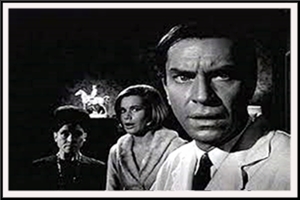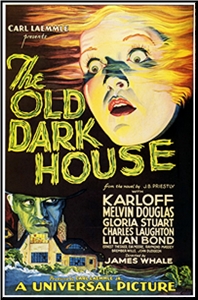November 2022
Monthly Archive
Wed 30 Nov 2022
Posted by Steve under
Reviews[8] Comments
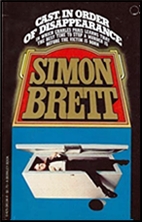
SIMON BRETT – Cast, in Order of Disappearance. Charles Paris #1. Gollancz, UK, hardcover, 1975. Charles Scribner’s Sons, US, hardcover, 1975. Berkley, US, paperback, 1979. Dell, US, paperback, 1986.
The British entertainment industry is the target of some rather pointed jabs as a new sleuth makes his debut. He’s actor Charles. Paris, now 47, and relegated to BBC radio productions and third-rate horror movies , with a tendency toward drink and dalliance. Without quite knowing how, he finds himself in a [mystery] affair of dirty pictures and the pretty young widow of an aging producer.
His actor’s voice and disguises do come in handy, but this is not a whodµnit, the questions are [rather] how and why, built precariously on coincidence and second-hand clues. Veddy British, but with undeniable charm and humor. Paris is an engaging fellow, in spite of his faults,. and hints are that he’ll soon return.
Rating: B
– Very slightly revised from The MYSTERY FANcier, January 1977 (Vol. 1, No. 1)
Mon 28 Nov 2022
REVIEWED BY TONY BAER:
RAOUL WHITFIELD – Green Ice. Knopf, hardcover, 1930. Also published as The Green Ice Murders. Avon Murder Mystery Monthly #46, paperback, 1947. Avon Classic Crime, paperback, 1971. Gregg Press, hardcover, 1980. Quill, paperback, 1986. Comprised of the following oulp magazine short stories:
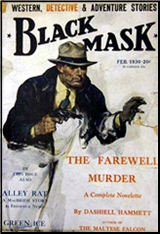
Outside, Black Mask December 1929
Red Smoke, Black Mask January 1930
Green Ice, Black Mask February 1930
Oval Face, Black Mask March 1930
Killer’s Show, Black Mask April 1930
Mal (short for Malcolm) Ourney just got out of Sing Sing in Ossining. Like literally just walked out.
He’d served two years on a vehicular manslaughter rap he took for his lush girlfriend, Dot Ellis. He’s a gallant kind of fellah and figured since Dot got drunk on his liquor, and was driving his car with him in it, it was kinda his own fault anyway. So he plucked her out of the driver’s seat, and sat in there himself.
While in stir, Mal and Dot go their separate ways. Dot’s the road to perdition.
Dot’s always gonna glom onto some guy, and trade her wares for bed, board and booze. That was really no surprise to Mal and he wasn’t too heartbroken over it.
Dot hooks up with a rising hood who hoodwinks a Colombian playboy out of five emeralds, cut like coffins, worth 50 grand a piece. The hood lets Dot hold onto them, for now. And forever, since when the big fish find out the small one is getting ideas and planning to cut out the bosses, they teach him a lesson he won’t forget. With a bullet.
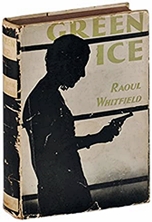
Meantime Mal spends his time in ‘Sing Song’ getting sick of the broken record. The big bastards using the small time hoods to do their all their dirty work, then framing them and sending them up the river (literally up the Hudson River), or giving them a dose of lead poisoning.
Mal decides when he gets out he’s gonna get some revenge on the big bastards that are puppeteering all the little hoods like marionettes. The cops are worthless as they’re bought and paid for by the big guys.
So he figures it’s up to him to start using the little guys to go after the big guys. To get them to wake up to the fact that they’re being played. Because though the lumpen-proles do all the dirty work they get stuck with the shitty end of the stick with all the coin rolling uphill while the shit rolls down.
But guess who’s at the gates to meet Mal when he gets out? It’s his long lost gal: Dot. And Dot has some green ice she’s ready to share. She needs a bit of protection now that her man is under ground.
But Mal isn’t having any. He won’t even let Dot get a word in. He doesn’t wanna hear it. It’s not that he’s mad at her or anything. It’d be like getting mad at a piranha for being a piranha. He’s just onto his life’s work. The work of a freelance reformer, kicking against pricks. And Dot’s not exactly good company. Pricks never being something she’d kick at.

So Mal goes his way and Dot goes hers. But her long ride’s cut short. By more bullets.
But somewhere along the way the emeralds have been lost. Maybe not lost, but passed around like whatever the opposite of hot potatoes are. Cold green potatoes. Everybody wants ’em. But nobody can keep them for long and keep breathing.
Since Dot had ’em and went up to see Mal, everybody figures Mal’s got ’em. Mal knows he hasn’t got ’em. And all he wants is to clean up graft.
He tells everyone that will listen that all he wants to do is to clean up graft. But nobody will listen. Everybody just figures he’s joking or using it as a cover for nefarious, green, and sparkling ends.
Mal doesn’t carry a gun. And, if I’m counting right, he accounts for zero deaths in the entire novel. He’s no pacifist and is a decent puncher. But he’s got no use for gats. Or emeralds. He just wants justice.
Yet everywhere Mal goes and everyone Mal sees ends up shot dead or trying to kill him. Or both.
All for emeralds. That turn out to be as fake as a Maltese falcon.
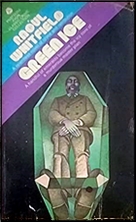
And though Mal’s quixotic quest for justice was damned from the start, at the end he turns Pollyanna. He figures all the dead bodies of all the dead hoods killed at least a few that might be classified as kind of ‘big’. So, hey! Like Dubya said about the middle east: Mission Accomplished!
Like Bogie ad libbed from old Billy Shakespeare: It’s the stuff that dreams are made of. Hardboiled dreams of small fry crooks and reformers. All fun house horizons and shattered glass.
It’s tightly written with tight staccato prose. Words like bullets from a tommy gun.
It’s good. It’s not Red Harvest , but it’s on the same planet, with similar characters and similar taut precision. Written by a guy that’s maybe not Hammett but no small shakes in his own right.
There are eight million stories in the naked city. This is one of them.
Sun 27 Nov 2022
REVIEWED BY DAVID VINEYARD:

THE OUTER LIMITS “The Bellero Shield” ABC. 10 February 1964. Martin Landau, Sally Kellerman, Chita Rivera, Neil Hamilton, John Hoyt as the voice of Bifrost, Vic Perrin the voice of Control. Teleplay by Joseph Stefano. Story by Lou Morheim and Joseph Stefano (Leslie Stevens uncredited). Directed by John Brahm.
If somehow you have never seen this episode this review contains SPOILERS!
“…when this passion becomes lust, when its flame is fanned by greed and private hunger, then aspiration becomes ambition by which sin the angels fell.”
— the voice of Control introducing “The Bellero Shield.”
Heady stuff, but pretty standard for The Outer Limits, the SF anthology series taking control of your television set weekly (“We control the horizontal. We control the vertical.”) that took the pretentious voice of Science Fiction Theater (Truman Bradley) and the social awareness of Rod Serling’s The Twilight Zone, the monsters of Boris Karloff’s Thriller, and the sheer oddity of One Step Beyond, and dressed it up with a stronger than usual science fictional dressing (not that it was particularly deep science fiction in most episodes).
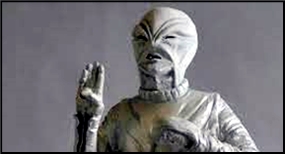
In “The Bellero (pronounced bell-a-ru) Shield” Martin Landau is scientist Richard Bellero who has spent his life seeking the approval of his father cold demanding Richard Senior (Neil Hamilton, who had appeared in another role in the anthology series the week before). Richard is experimenting with a laser from the laboratory in the top floor of his mansion, and as usual has failed to garner his father’s support.
Senior expects his son to discover something that will make him immortal and cover the Bellero name in glory. Money means nothing.
Richard is of course upset, but not as upset as his wife Juidth (played with icy femme fatale perfection by Sally Kellerman) who is not content with money. Judith has long dreamed of what she remembers from childhood as “the trembling way,” a metaphor for the Nordic rainbow bridge Bifrost that bridges heaven and earth, not mere wealth (Richard has more than enough of that without his father), but godlike power and prestige.
Between Senior’s lust for glory and Judith’s passion for power Richard is pretty much screwed, and we mustn’t forget Judith’s almost alien Mrs. Danvers-like devoted servant in black the barefoot creepy and unnaturally devoted Mrs. Dane (Chita Rivera, whose bare feet in this episode should get a second credit).
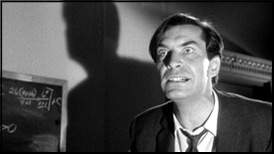
To be honest, Landau, a first class over-actor himself, has little to do here against Kellerman’s cold hearted Randian goddess, Hamilton’s Miltonic patriarch, and Rivera’s satanically devious servant. It may be the only time in his career his is the most normal character in the cast.
Enter what Stefano, who co-produced the series, called the “Bear,” the thing that made The Outer Limits different than every other similar anthology series, the monster of the week. Of course we aren’t talking your average “bear” (sorry about that, couldn’t resist) in most cases. More often than not the “bear” was the most sympathetic character in any episode and the real monsters wore human skin, and it was always a semi science-based monster, no vampires, witches, or werewolves, though BEM’s were welcome.
Here the “bear” is an alien transported to Earth by Richard’s laser beam. This alien, christened Bifrost (voiced by John Hoyt) is an advanced being who almost immediately has a shared scientific bond with Richard, but Judith is less interested in exploiting the first contact with a creature from another world than getting her hand on the shield that protects Bifrost, an impenetrable protection that can be extended to cover vast areas from a single unit.
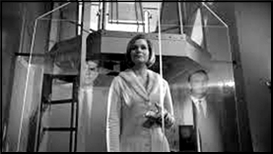
Judith sees the shield as the key to her ambition and pressures Richard to bring back his Father so she can show it to him, but while Richard is gone, Bifrost is becoming anxious to return home, afraid he will miss his chance, and after a well-written scene where he sums up Judith by “reading her eyes” (“Throughout the Universe all species that have eyes can be understood through them.”), he tries to leave and Judith kills him hiding him in the cellar with Mrs. Dane’s help.
Richard returns with his father, and Judith shows him the shield, allowing Mrs. Dane to fire a harmless bullet at her and Senior a laser weapon Richard invented, but when she goes to turn the shield off, she cannot. She is trapped and nothing can penetrate the shield whose protection projects far into space and deep in the Earth (that Heaven and Hell metaphor is no accident here).
Meanwhile Senior and Mrs. Dane clash over the body of Bifrost. Senior telling Mrs. Dane who is trying to hide the body: “Great men are forgiven their murderous wives,” when she warns him Richard too will be implicated before Mrs. Dane pushes him down the basement stairs.
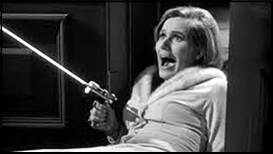
This all owes more to Weird Tales or Unknown than most Science Fiction, more in line with H. P. Lovecraft or Clark Ashton Smith and the kind of SF represented by William Sloane’s The Edge of Running Water and To Walk the Night, C. S. Lewis That Hideous Strength, Jack Finney’s Invasion of the Body Snatchers, or John Christopher’s The Psychogeists. It is the dark nightmare edge of Science Fiction, less the literature of ideas than the monsters of the id they set free. Outer Limits avoided the fantasy and whimsy of some Twilight Zone episodes and the cheeky nihilism of Alfred Hitchcock Presents, but does lay it on a bit heavy at times. This one just skirts that, finding a solid footing despite all the Gothick trappings and foundation in basic Greek Tragedy 101.
At times “The Bellero Shield” makes you wonder if writer/producer Stefano happened to read Edith Hamilton’s Mythology the week before while brushing up on his Freud and Jung.
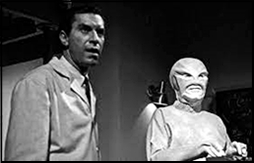
Bifrost isn’t dead, much to Mrs. Dane’s chagrin and we get yet another metaphor, this one Christian as Bifrost sacrifices himself to save Judith, who tried to kill him.
“I expected it to kill me,” Mrs. Dane says, “but it looked into my eyes and I heard myself saying: ‘Can you help me?’
And it said: ‘Can I not?’
Unlike some of the other series mentioned here The Outer Limits episodes were more likely to end in irony than rough or ironic justice. Here Judith is freed from the shield, but when Richard tries to comfort her telling her it is gone and now they can go to the authorities and try to explain what has happened, Judith reveals she has been driven mad and will always be a prisoner of the Bellero shield: “No, it’s here. I can see it. It will always be here. Nothing can remove it. Nothing…Nothing!”
And as Control reminds us before returning control of your television to you:
“…when this passion becomes lust, when its flame is fanned by greed and private hunger, then aspiration becomes ambition by which sin the angels fell.”
Boris, Rod, and Sir Alfred couldn’t have said it better.
Sat 26 Nov 2022
Posted by Steve under
Reviews[15] Comments
REVIEWED BY JIM McCAHERY:
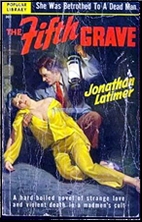
JONATHAN LATIMER – The Fifth Grave. PI Karl Craven. Popular Library, 1950.
Jonathan Latimer’s The Fifth Grave has an interesting publishing history, having been originally published by Methuen in England in 1941 under the author’s own title, Solomon’s Vineyard. Its first appearance in the U.S. was in Mystery Book Magazine (August, 1946), and [until now] the first and only appearance in book form is the December, 1950 Popular Library edition (#301), with a subsequent second printing in April of the following year. All of Mr. Latimer’s other books appeared first in the U.S. in hardcover editions.
Narrator and private eye Karl Craven from St. Louis .discovers his partner Oke Johnson shot dead in Paulton where they had come to rescue a client’s niece, Penelope Grayson, -from a religious cult group located near town at Solomon’s Vineyard. The founder, Solomon, lies in state in their imposing white temple — “the temple that bootleg built.”
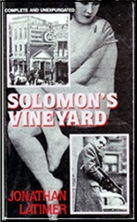
The business end of the vineyard is naturally in other than unsoiled hands and Craven has quite a time separating the wheat from the chaff, especially since he must save a seemingly doped Penelope before the impending Ceremony of the Bride, a Walpurgis Night when she is to become the fifth wife of the dead Solomon, with her grave already dug and complete with headstone.
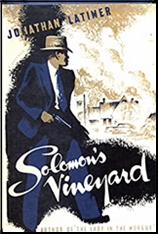
A far cry from Latimer’s series investigator William Crane, Craven is as hard-boiled as they come. An egoist, he justifies all his actions; anything goes, he feels, when it’s question of “fighting fire with fire.” His likes are simple — food, fighting, women, and liquor. Some scenes are definitely not for those with weak stomachs. like the one in which Craven forces an antagonist’s head through prison bars, sacrificing some skin in the process.
On the obese side, Karl Craven becomes an object of worship himself by the masochistic nympho princess residing at the Vineyard. He narrowly escapes death twice, including a fabulous scene in a steak room. There is quite a bit of action and suspense with more than one surprise before the case is resolved to the mutual satisfaction of Craven and the client. Written in a terse and often brutal language, it has to be a classic of its kind.
– Reprinted from The Poison Pen, Volume 4, Number 3 (June 1981).
Sat 26 Nov 2022

Some of you may have noticed that my son Jonathan hasn’t been writing movie reviews for the blog the way he used to. Unfortunately, for the past six months, he’s been battling some severe physical health problems. After a visit to the ER in July, he has been suffering from numerous health issues and tentatively diagnosed with at least one immune dysfunction problem. It’s been a battle for both of us, but it’s been made especially worse because he was looking forward to a “return to normal” after the pandemic lockdown.
Luckily he’s living in the Los Angeles area, where there are doctors who know about such disorders and who are experts in both diagnosing and treating them. This does take up time for both him and me, though, and the appropriate treatments may prove to be expensive. Sadly he can’t work right now, so I’m trying to sell off a good portion of my book collection to help out.
For now I’m planning on keeping the blog going, but only at the current reduced rate of a post a day. The days of two or even three posts a day are long over!
Fri 25 Nov 2022
A 1001 MIDNIGHTS Review
by Julie Smith
WILLIAM L. DeANDREA – The Hog Murders. Niccolo Benedetti #1. Avon, paperback original, 1979. Intl Polygonics Ltd, paperback, 1999.
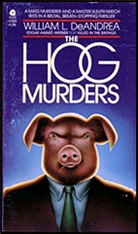
DeAndrea’s second Edgar-winner is a wonderfully old-fashioned puzzle mystery, complete with serial killer and a master detective reminiscent of Nero Wolfe or even the great Holmes himself. The eccentric but brilliant Professor Niccolo Benedetti is assisted by his pupil, Ron Gentry, a young private eye based in snowy Sparta, New York.
Sparta is being terrorized by a homicidal maniac who, in the tradition of serial killers, writes notes to a local journalist, in this case likable Buell Tatham. He signs himself “Hog,” and the cover of this paperback is a particularly arresting one, showing a stocky man’s upper body topped by the monstrous head of a pig. Hog’s methods are as clever as they’re diabolical; his victims are random and almost invariably innocent — even a child is killed. But Benedetti, of course, is a little too quick for him.
The solution is truly unexpected, yet really as obvious as who killed Roger Ackroyd; in other words, the reader is fooled but could kick himself for it. Bonuses are the trademark DeAndrea wit and the withholding of the complete solution until the very last sentence.
In addition to his mysteries, DeAndrea has published a number of non-series suspense novels, including The Lunatic Fringe (1980), which is set in New York City during the Gay Nineties; and Cronus ( 1984), a thriller about an apparent terrorist killing in the sleepy town of Draper, Pennsylvania. DeAndrea has also published one novel to date under the pseudonym Philip Degrave, Unholy Moses (1985).
———
Reprinted with permission from 1001 Midnights, edited by Bill Pronzini & Marcia Muller and published by The Battered Silicon Dispatch Box, 2007. Copyright © 1986, 2007 by the Pronzini-Muller Family Trust.
The Niccolo Benedetti series —
The Hog Murders. Avon 1979
The Werewolf Murders. Doubleday 1992
The Manx Murders. Penzler 1994
Thu 24 Nov 2022
Posted by Steve under
Reviews1 Comment
REVIEWED BY DAN STUMPF:
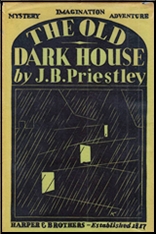
J. B. PRIESTLEY – The Old Dark House. Harper, hardcover, 1928. Published in the UK as Benighted (Heinemann, hardcover, 1927). Films: Universal, 1932; Hammer, 1963.
It’s been a season for reading some Old Chestnuts, the first of which was J.B. Priestley’s The Old Dark House, which turned out to be a neatly – perhaps too neatly — constructed variation on the … well, on the Old Dark House theme, with a group of disparate travelers stuck on a dark and stormy night in a remote mansion inhabited by an equally disparate household of lunatics, criminals and potential killers.

This was hoary stuff even in the 20s, and Priestley’s stated intent was to use the shuddery conventions as a showcase for his talents with Character and Dialogue, which he does — a little too clearly. One is sometimes reminded a bit forcefully that these are all supposed to be Honest-To-Gawd Characters, and their lines intended to be Highly Dramatic and Very Important.
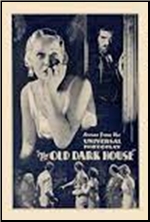
Still, as a writer J.B. was no slouch, and The Old Dark House does offer its share of clever talk and sho’ ’nuff thrills; indeed, the Chills are cunningly crafted to appear in ascending order, with effective foreshadowing and a resolution that is entirely too pat, but handled rather well.
There is a very fine scene late in the book, with the surviving characters, exhausted by their Night of Horrors but too wrought-up to sleep, slumped exhausted in musty armchairs, trying to find some meaning in all this as they prepare to face a gray and uncompromising dawn. And if the preceding pages aren’t all up to that level of writing, well, at least they aren’t a chore to get through.
— Reprinted from A Shropshire Sleuth #78, July 1996.
Wed 23 Nov 2022
Posted by Steve under
Reviews[3] Comments
IT IS PURELY MY OPINION
Reviews by L. J. Roberts
KERRY GREENWOOD – The Lady with the Gun Asks the Questions. Phryne Fisher, short story collection. Poisoned Pen Press, hardcover, 2022. Setting: Australia, 1920s.
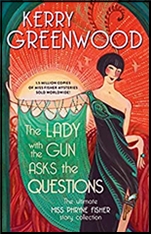
Opening: Dear Reader, Thank you very much for buying this book (and if you haven’t bought it yet, please do so — I have cats to feed…)
Only Kerry Greenwood could make an “Apologia” as interesting and delightful to read as the actual stories. Not only do I recommend readers start with that, but also not skip “On Phryne Fisher” which is the author’s introduction. From there, one jumps into the wonderful world of 17 absolutely wonderful short stories. There is also a very helpful Glossary at the end.
As per usual, one always has favorite stories:
“Hotel Splendide,” a case of a missing husband and a missing hotel room, starts one off with the perfect amount of information as to Phryne’s background, her style, her ability to take charge, and her enviable sangfroid.
“The Body in the Library” pairs Phryne and DI Jack Robinson and a not-so-pious reverend.
“Death Shall be Dead” includes DI Jack Robinson and a dog. How can one resist that?
and
“The Bells of St. Paul’s” begins with a tea at the Windsor that leaves one salivating, and a message in the bells.
One wishes a few of the stories were novellas and a couple would make wonderful full-length novels.
The book is probably more for fans of Phryne than those new to her. There’s not a lot of introduction to the secondary characters. The settings and the time at which the story occurs also jumps around a bit. Even so, for new readers, this is an excellent way to experience Phryne and her world, and for those who already love Phryne, there is still the overwhelming desire to be her when one grows up.
The Lady with the Gun Asks the Questions is a treat. Some of the stories were previously published, some have been reworked slightly, and four are brand new. They are piquant, thoroughly entertaining, and not overly complicated. One may read one, a few, or all of them at a sitting as reading them may have the effect of potato chips; one just isn’t enough.
Rating: VG Plus.
Tue 22 Nov 2022
Posted by Steve under
Reviews[3] Comments
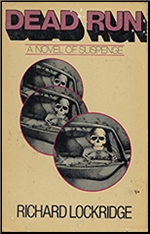
RICHARD LOCKRIDGE – Dead Run. Inspector Heimrich. Lippincott, hardcover, 1976. No paperback edition.
It’s late December, and an ice storm hits New York’s suburban Putnam County. Ah, that brings back memories of slick roads, downed power lines and stranded travelers. A lawyer friend of Inspector Heimrich is killed by a car in a parking lot, and a witness to the murder is the girl Heimrich’s stepson brought home as an unexpected surprise for the holidays.
Quite comfortable reading, a pleasure to relax with old friends capable of coping with disrupted routine.
Rating: A minus
– Very slightly revised from The MYSTERY FANcier, January 1977 (Vol. 1, No. 1)
Mon 21 Nov 2022
Posted by Steve under
Reviews[4] Comments
REVIEWED BY TONY BAER:
ROSS THOMAS – Chinaman’s Chance. Arthur Case Wu & Quincy Durrant #1. Simon & Schuster, hardcover, 1978. Avon, paperback, 1979. Mysterious Press, paperback, 1988.
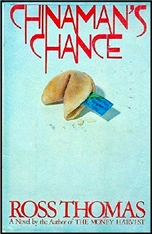
A few years ago some dude named Malcolm Jones (who I’ve never heard of) shared his top ten list of crime novels. All the ones I’d already read were great, lending the list some credibility. The ones I hadn’t have been great too. Chinaman’s Chance made the grade. So I was impelled to try it out.
A ramshackle ramble by the seat of its pants, the story is an entertainment. A wonderful entertainment. And of perhaps all the novels I’ve ever read, it deserves that moniker. It strives to be nothing other than entertainment. And it succeeds. Wonderfully and wonderfully vacuous.
There are so many plot threads that it will be hard to relay them in linear, straightforward fashion. God knows that Thomas didn’t try to do it. And yet it is the multiple perspectives and slowly eked out details that makes the damn thing so tantalizing, anticipated and delicious.
I’ve read that Woody Allen only gives his actors their own lines to remember and they have no idea how the whole script fits together. That’s the feeling you get from the characters here. No one has the whole picture. Everyone has just a little piece. And the story reveals itself like a picture puzzle put together, piece by piece, before your eyes. But this picture puzzle you bought came in a blank cardboard box. So you have no idea ahead of time how the thing is supposed to look.
In fact I’d be surprised if Thomas knew ahead of time how it all was going to fit together. If he did, and outlined it all ahead of writing it, then he’s a freaking genius. If not, then he’s really really lucky. Because all of the pieces in this 5000 piece puzzle fit. Even though it seems like he’s manufacturing the puzzle pieces right before your very eyes.
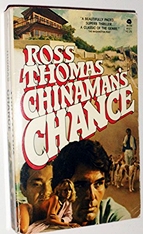
But hey. I’ll have a try at linear summary.
Artie Wu and Quincy Durant are soldiers of fortune. Back when the Vietnam war was petering out, there was money to be made. An associate of theirs at the US Embassy, Reginald Simms, was given orders to burn the 12 million in U.S. currency on hand. He burned 10 million of it.
The other two mil? Simms and his college roommate, a major mafia figure, ‘buy’ the political machinery of the small broken down coastal town of Pelican Bay in Southern California.
The dream? To build a red-light district version of Epcot Center: “[S]in without sorrow and thrills without danger…. You can go from Paris to Berlin…. to Singapore to Hong Kong to Marseilles to London’s Limehouse to San Francisco to New Orleans to New York to wherever you have ever dreamed of going. It will all be within this four block square area, and whatever you have dreamed of finding in those places you will find here — carefully sterilized for safe consumption…. People don’t want the real thing… because the real thing has bad breath, and sweaty armpits, and sometimes steals your wallet and makes you hurt when you pee. What people want is vice and sin that look the way they look in the movies — and that’s exactly what we intend to give them.â€
So what’s wrong with it? Well maybe nothing in principle. But the devil’s in the details. And whether the end justifies the means.
Part of the means involved screwing over Artie Wu and Quincy Durant back in Vietnam. Including getting Durant’s fiancé murdered by the Viet Cong.
And part of cleaning out the old Pelican Bay political machinery involves killing a Congressman opposed to graft. And the Congressman’s wife. And the Congressman’s mistress.
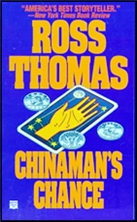
So that’s basically the story. It’s about Artie Wu and Quincy Durant seeking vengeance and a cool $2 million coming up against the mob.
It’s supremely entertaining. And another thing that surprised me is how Tarantinoesque the thing is. And it predates Tarantino by more than a decade. So the phrase shouldn’t be Tarantinoesque. Tarantino is being RossThomaseque. It’s all there: the combination of brutal violence and slapstick comedy.
There are a number of great scenes so it’s hard to pick one to illustrate the point. But my favorite involves a couple of hitmen who’ve taken their target in a Winnebago, intending to throw him off a cliff near Pepperdine University. They lecture the murderee on having made bad career choices. Then they are distracted as it dawns on them that Pepperdine’s campus appears in The Six Million Dollar Man! The murderee leverages their distraction by grabbing a can of gasoline and setting them on fire while the Winnebago flies off a cliff.
So yeah. It’s like that. And if it sounds like your bag, give it a read. It’s a great movie to watch in the theater of your mind. Grab the popcorn.
Next Page »











